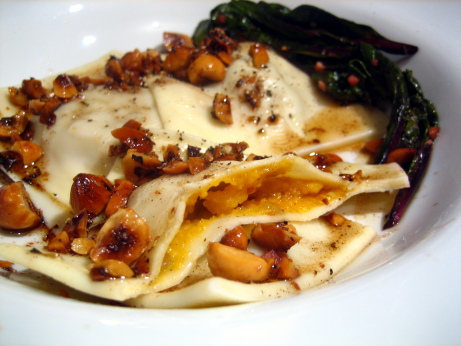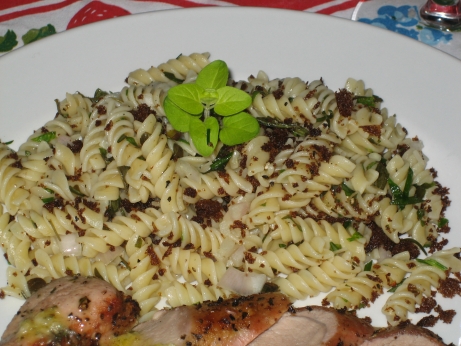This dish was my contender in our ongoing series of food battles. They faced off against my dining companion’s lovely beet and ricotta stuffed ravioli, which turned a vibrant fuchsia as they cooked. As is always the case with these battles, we both think we’ve won, because we’ve chosen recipes that suit our moods that night. The only way to solve this is to get an outside expert to come eat with us. My sister loves the idea of judging my food, but she doesn’t eat red meat, which limits her judging potential. This battle was completely meat free, and we just forgot to invite her. She brings it up every time I see her, and I don’t think she’ll forgive me ’till I show up on her doorstep with a ravioli sampler platter.
The ravioli came together easily. You start by roasting a butternut squash, scooping it out, and mashing the flesh. You then brown onion in butter with sage salt and pepper, and mix it into the squash, along with some of the oldest, hardest, and stinkiest goat cheese you can get your hands on. The squash is then distributed among 60 wonton wrappers, and sealed up. You can do all of this ahead, and refrigerate the ravioli ’till dinner time. While the water for the ravioli is coming to a boil, you brown butter with chopped toasted hazelnuts. The ravioli are boiled for a few minutes, and served with the hazelnut-brown butter drizzled on top.
I cheated with this recipe. I decided to do about five times more work than The Book called for, and made my own pasta for the ravioli. Wonton wrappers are just fine, and work quite well for ravioli, but I really prefer fresh pasta for applications like this. The texture is just that much more appealing, and in theory you have much more control of the shape (in practice some of those shapes are a little wonky). Making pasta is a pleasant way to spend an afternoon, and the rolling is exceedingly satisfying. The ravioli were very good, and I think that’s in part due to the pasta. I imagine they’d be fairly similar with wonton wrappers though.
These ravioli were really hearty. They were absolutely delicious, and intensely flavourful. In fact they were so flavour packed that I’d only want to eat two or three of them. They would work best as one course in an elaborate dinner. Roasted butternut squash is high on my list of good things in this world, and it has a wonderful affinity for sage and goat cheese. The flavour pairings in this dish are absolutely right, everything is well proportioned, and it tastes rich and luxurious without being overwhelming.
I could have lived without the hazlenut-brown butter sauce. It was nice and all, but I didn’t find it all that necessary. Preparing the hazelnuts was a hassle, they had to be toasted, and then rolled in a cloth to get their skins off. Unfortunately the skins didn’t quite come all the way off, and flecks of skin ended up burning in my butter, adding unattractive black specks, and a bit of a charred flavour. The ravioli were certainly rich enough without adding nuts, and it was possibly one flavour too many. A little brown butter would have been a nice accompaniment, but the hazelnuts were overkill.
I was very well pleased with my entry to Battle: Ravioli. I’d absolutely make these again, and I’d probably make a double batch just to stash some in the freezer.

